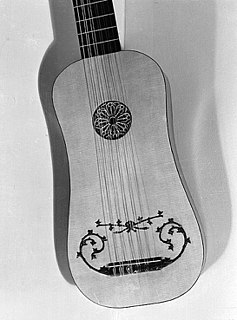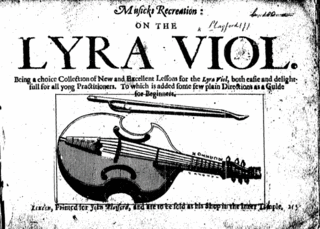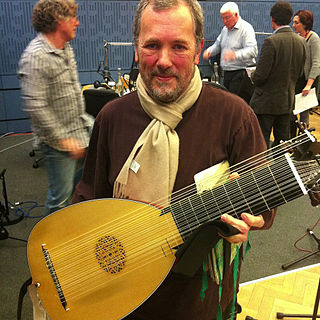
A lute is any plucked string instrument with a neck and a deep round back enclosing a hollow cavity, usually with a sound hole or opening in the body. It may be either fretted or unfretted.

The viol, viola da gamba, or informally gamba, is any one of a family of bowed, fretted and stringed instruments with hollow wooden bodies and pegboxes where the tension on the strings can be increased or decreased to adjust the pitch of each of the strings. Frets on the viol are usually made of gut, tied on the fingerboard around the instrument's neck, to enable the performer to stop the strings more cleanly. Frets improve consistency of intonation and lend the stopped notes a tone that better matches the open strings. Viols first appeared in Spain in the mid-to-late 15th century, and were most popular in the Renaissance and Baroque (1600–1750) periods. Early ancestors include the Arabic rebab and the medieval European vielle, but later, more direct possible ancestors include the Venetian viole and the 15th- and 16th-century Spanish vihuela, a 6-course plucked instrument tuned like a lute that looked like but was quite distinct from the 4-course guitar.

Heinrich Isaac was a Netherlandish Renaissance composer of south Netherlandish origin. He wrote masses, motets, songs, and instrumental music. A significant contemporary of Josquin des Prez, Isaac influenced the development of music in Germany. Several variants exist of his name: Ysaac, Ysaak, Henricus, Arrigo d'Ugo, and Arrigo il Tedesco among them.

Francesco Canova da Milano was an Italian lutenist and composer. He was born in Monza, near Milan, and worked for the papal court for almost all of his career. Francesco was heralded throughout Europe as the foremost lute composer of his time. More of his music is preserved than of any other lutenist of the period, and his work continued to influence composers for more than a century after his death.

The vihuela is a 15th-century fretted plucked Spanish string instrument, shaped like a guitar but tuned like a lute. It was used in 15th- and 16th-century Spain as the equivalent of the lute in Italy and has a large resultant repertory. There were usually five or six doubled strings.

Arnolt Schlick was a German organist, lutenist and composer of the Renaissance. He is grouped among the composers known as the Colorists. He was most probably born in Heidelberg and by 1482 established himself as court organist for the Electorate of the Palatinate. Highly regarded by his superiors and colleagues alike, Schlick played at important historical events, such as the election of Maximilian I as King of the Romans, and was widely sought after as organ consultant throughout his career. The last known references to him are from 1521; the circumstances of his death are unknown.

Conrad Paumann was a German organist, lutenist and composer of the early Renaissance. Even though he was born blind, he was one of the most talented musicians of the 15th century, and his performances created a sensation wherever he went. He is grouped among the composers known as the Colorists.
Elias Nikolaus Ammerbach was a German organist and arranger of organ music of the Renaissance. He published the earliest printed book of organ music in Germany and is grouped among the composers known as the Colorists.

Ludwig Senfl was a Swiss composer of the Renaissance, active in Germany. He was the most famous pupil of Heinrich Isaac, was music director to the court of Maximilian I, Holy Roman Emperor, and was an influential figure in the development of the Franco-Flemish polyphonic style in Germany.
Leonhard Kleber was a German organist, and probably composer, of the Renaissance.

The lyra viol is a small bass viol, used primarily in England in the seventeenth century.

Nigel North is an English lutenist, musicologist, and pedagogue.
The decade of the 1510s in music involved some significant events.
The decade of the 1530s in music involved some significant events, publications, compositions, births, and deaths.
The decade of the 1540s in music involved some significant events.
The Choralis Constantinus is a collection of over 375 Gregorian chant-based polyphonic motets for the proper of the mass composed by Heinrich Isaac and his pupil Ludwig Senfl. The genesis of the collection is a commission by the Constance Cathedral for Isaac, at that time the official court composer for the Holy Roman Emperor Maximilian I, to compose a set of motets for the special holy days celebrated in the diocese of Constance. Isaac was in Constance at the time with the Imperial court as Maximilian had called a meeting of the German nobility (Reichstag) there. The music was delivered to the Constance Cathedral in late 1508 and early 1509.

Hans Neusidler, was a German composer and lutenist of the Renaissance.
This is a list of notable events in music that took place in 1552.

Hieronymus Andreae, or Andreä, or Hieronymus Formschneider, was a German woodblock cutter ("formschneider"), printer, publisher and typographer closely associated with Albrecht Dürer. Andreae's best known achievements include the enormous, 192-block Triumphal Arch woodcut, designed by Dürer for Maximilian I, Holy Roman Emperor, and his design of the characteristic German "blackletter" Fraktur typeface, on which German typefaces were based for several centuries. He was also significant as a printer of music.












